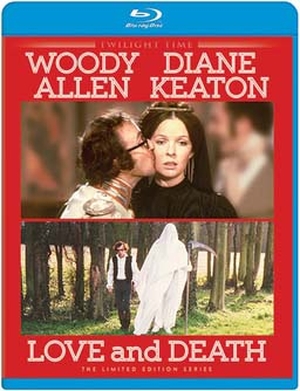
BY RAYMOND BENSON
The
last of Woody Allen’s “early, funny†films, 1975’s Love and Death, is a delight, especially for those in the audience
who already have an appreciation for Russian literature (e.g., Tolstoy, Dostoyevsky)
and classic foreign cinema (e.g., Eisenstein, Bergman). Unlike his previous
works in the late sixties and early seventies, Love and Death is targeted more to a hip, intellectual audience,
the one that has pretty much remained his loyal following ever since. It was
after this picture that Allen began to specialize in the art-house, mature, and
less-zany comedies about relationships that became his trademark (Annie Hall was Allen’s next film, in
1977).
If
you’re able to get all the references to War
and Peace and The Brothers Karamazov or
to Battleship Potemkin and The Seventh Seal, then Love and Death is indeed one of the funniest—if
not the funniest—pictures Allen ever
made, as well as one of the best comedies of that decade. Not only is the
movie’s script witty and smart, the two stars—Allen and Diane Keaton—are in top
satirical form. Keaton, specifically, comes into her own with dead-on comic
delivery.
There
are terrific gags all the way through, such as when Woody has to enlist in the
Russian army and finds himself berated by a tough, all-American, black drill
sergeant. Or the one about his father that “owns a piece of land†(and he carries
it around with him). Or the ongoing pseudo-philosophical discussions between
Allen and Keaton that contain such lines as—
Allen: “Nothingness... non-existence... black emptiness...â€
Keaton: “What did you say?â€
Allen: “Oh, I was just planning my future.â€
Another
plus for the movie is its score, almost all of it taken from orchestral pieces
by Prokofiev. The composer is a perfect choice for his music’s liveliness and
obvious Russian flavor. You’ll actually find yourself humming the main theme
(from Lieutenant Kijé Suite) for a few days after a viewing.
After
making his previous few films in the U.S., Allen shot the picture in France and
Hungary; afterwards he swore he’d never make a movie outside of New York again.
For him, it was a horrible experience having to deal without the comforts of
home. At one point during the shoot he contracted food poisoning. Allen
eventually broke his homegrown decree in 1996 and has, more often since 2005,
made several films in Europe and England.
Twilight
Time’s release is limited to 3000 copies. Ghislain Cloquet’s colorful
cinematography looks great, but I’m not sure the image is that much better than
the original MGM/UA DVD. The only extra is the theatrical trailer and some
other Twilight Time trailers.
Nevertheless, if you’re a Woody Allen fan, and
if you don’t already own the DVD, you’d better grab this collector’s item fast
while there are still copies available. It’ll warm the cockles of your heart.
And, you know, that’s just great—there is nothing like hot cockles.
The Blu-ray contains an isolated music and effects track, a collector's booklet with liner notes by Julie Kirgo and the original theatrical trailer.
CLICK HERE TO ORDER FROM SCREEN ARCHIVES